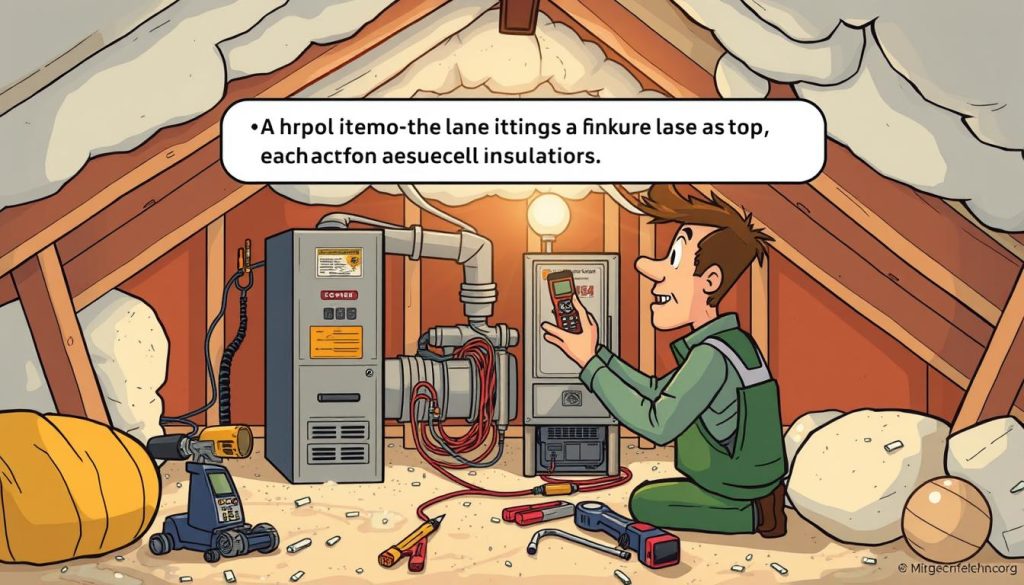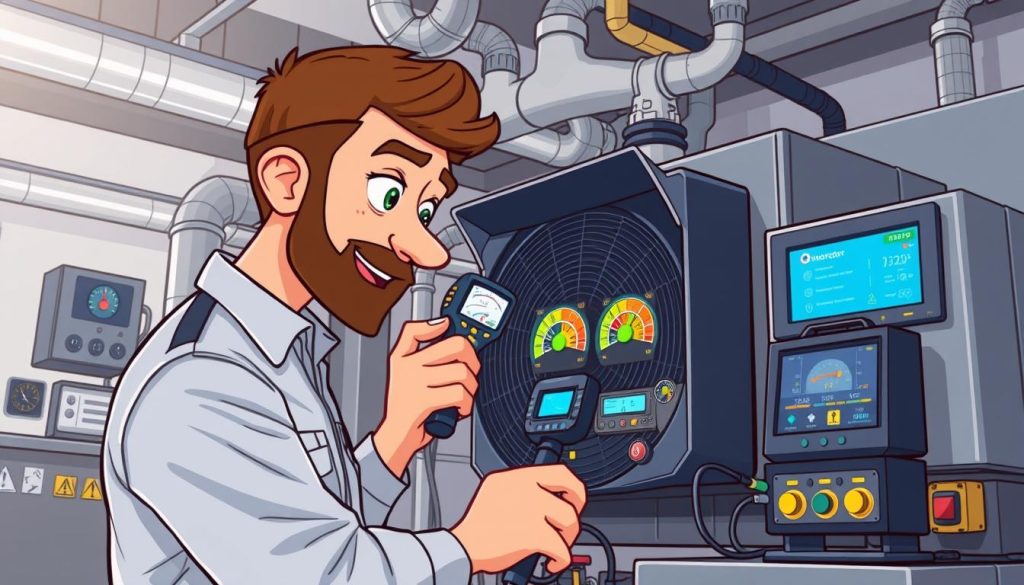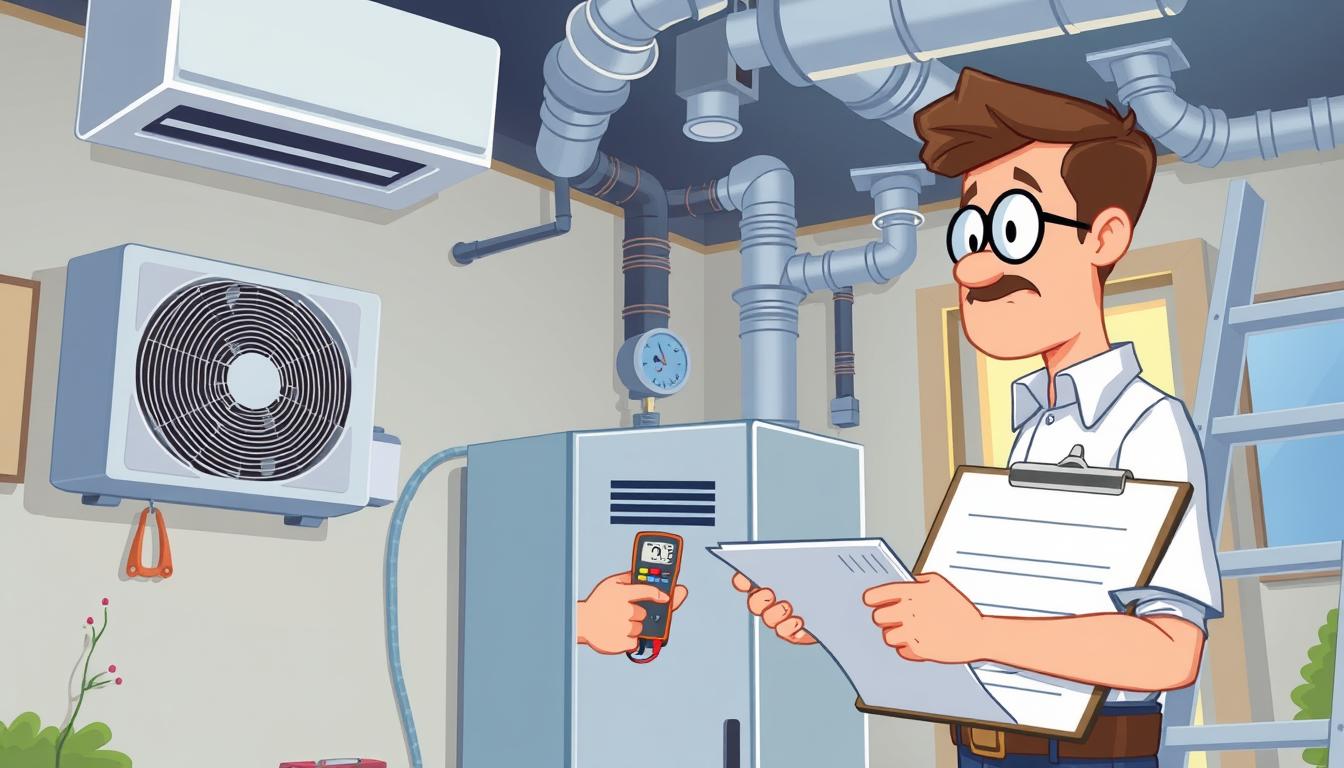Checking an HVAC (Heating, Ventilation, and Air Conditioning) system is key for comfort, energy savings, and equipment life. You need to look at the system’s age, condition, upkeep, type, airflow, insulation, and energy use. This helps spot problems and decide on upgrades or new systems. This guide will show you how to check an HVAC system well. It helps keep your space comfy, efficient, and healthy.
Key Takeaways
- Checking your HVAC system’s age and condition is vital for knowing when it might need to be replaced.
- Looking at the ductwork for damage, rust, or leaks can find efficiency issues and save energy.
- Going over maintenance records can tell you about the system’s care and any issues.
- Checking energy efficiency, airflow, and insulation can improve performance and cut costs.
- Thinking about preventive maintenance can make your HVAC system last longer and keep air quality good.
Check the Age of the HVAC System
Checking your HVAC system’s age is key to knowing its condition. HVAC systems usually last about 15 years. If yours is older, it’s time to think about getting a new one.
Knowing your HVAC system age helps you decide if it’s time for a new, energy-saving model. Older systems can be less reliable, harder to keep at a steady temperature, and use more energy. This can raise your bills.
How to Check the Age of Your HVAC System
- Look for a manufacturer’s label or sticker on the outdoor unit or inside the furnace cabinet. This should provide the installation date or the system’s serial number, which you can then use to determine the age.
- Check any documentation or maintenance records you have for the system. These may include the original purchase or installation paperwork.
- If you don’t have access to the installation date, you can estimate the age based on the system’s appearance and condition. Older systems tend to show more wear and tear, and the technology may be outdated compared to newer, more efficient models.
Understanding the HVAC lifespan and equipment replacement planning helps you plan ahead. Regular maintenance can also help your system last longer. But, eventually, you’ll need to replace it.
| HVAC System Age | Typical Lifespan | Replacement Considerations |
|---|---|---|
| 5-10 years | 15-20 years | System is still relatively new and likely efficient. Maintain regularly. |
| 10-15 years | 15-20 years | System is halfway through its lifespan. Consider replacement in the next few years. |
| 15+ years | 15-20 years | System is nearing the end of its lifespan. Budget for a replacement soon. |
Inspect the Condition of the Ductwork
When checking an HVAC system, it’s key to look at the ductwork. HVAC ductwork inspection is crucial. Any damage, rust, or leaks can lower system efficiency and raise energy costs.
Assess Duct Condition and Identify Potential Issues
Start by visually checking the ductwork for wear and tear. Look out for these issues:
- Damage: Search for cracks, holes, or physical damage to the ductwork.
- Rust: Check for corrosion or rust, which can weaken the system.
- Leaks: Look for air leaks, which can cause big energy losses and affect duct condition assessment.
Finding these problems early helps fix them before they get worse. This keeps the HVAC ductwork running well.
Understand the Impact of Duct Leaks
Duct leaks are a common problem with HVAC ductwork. Leaky ducts can greatly affect system performance, causing:
- Lower energy efficiency, as conditioned air escapes before reaching rooms.
- Higher energy costs, as the system works harder to keep temperatures right.
- Uneven heating or cooling, as some areas get less airflow.
- Potential indoor air quality issues, as leaks can let in dust, pollen, and more.
Fixing HVAC ductwork leaks is very important when checking the HVAC system’s condition.
Ask About Maintenance Records
Before buying a new home, it’s key to ask about the HVAC system’s maintenance history. Knowing how often filters were changed and any past issues can tell you a lot. Even a new home might not have a well-maintained HVAC system, so getting records is important.
Understanding the HVAC maintenance history and HVAC service records helps you see the system’s lifespan and future needs. Regular maintenance keeps the system running well and lasts longer. Without it, you might face higher energy bills, lower performance, and expensive repairs or early replacement.
To check the preventive maintenance importance of the HVAC system, ask these questions:
- When were the air filters last replaced, and how often are they typically changed?
- Has the system undergone any major repairs or component replacements in the past? If so, what were the issues and when did they occur?
- Has the system been serviced regularly by a professional HVAC technician? If so, how often and what was typically included in the maintenance visits?
- Are there any known issues or areas of concern with the HVAC system that the previous owner can share?
- Can the previous owner provide any maintenance records or service invoices to verify the system’s history?
Getting this info helps you decide on the HVAC system’s condition. It tells you if it needs more maintenance or might need to be replaced soon.
Understand the Type of HVAC System
It’s important to know the type of HVAC system in your home. There are three main types: forced-air, hot water, and radiant heat systems. Knowing this helps you understand your system better.
What is a Forced-Air HVAC System?
A forced-air system uses a central unit to move air through ducts and vents. It has a heat source and a cooling part. These systems are good at heating and cooling but need regular checks.
How do Hot Water HVAC Systems Work?
Hot water systems, or hydronics, use a boiler to heat water. This water is then sent through pipes to radiators or baseboards. They provide even heat but might cost more to start with.
What are Radiant Heat HVAC Systems?
Radiant heat systems use pipes or electric cables in floors, walls, or ceilings to heat. They offer efficient and even heat without needing air movement. But, they can be more expensive to install.
| HVAC System Type | Description | Advantages | Disadvantages |
|---|---|---|---|
| Forced-Air | Uses a central air handler or furnace to circulate air through ducts and vents | Efficient heating and cooling, versatile | Requires regular maintenance, can be noisy |
| Hot Water (Hydronic) | Uses a boiler to heat water and distribute it through pipes to radiators or baseboards | Even and comfortable heat distribution | Higher upfront cost, may be less efficient than forced-air systems |
| Radiant Heat | Uses a network of pipes or electric cables embedded in floors, walls, or ceilings to distribute heat | Efficient and even heat distribution, comfortable warmth | Complex to install, higher installation costs |
Knowing your HVAC system’s type helps you understand its condition and needs. This knowledge is key as you check your home’s heating and cooling system’s performance and efficiency.
Check the Air Vents
When checking your home’s HVAC system, look at the air vents. Make sure they are open, clear, and in good shape. This is key for good airflow and system efficiency.
Are All Air Vents Open and Unobstructed?
Walk through each room to check the air vents. Make sure nothing blocks them, like furniture or curtains. Blocked vents can hurt airflow, making your home less comfortable.
Check behind big furniture to see if anything is blocking the air. This is important for keeping your home cool or warm.
Are the Air Vents in Good Condition?
Look at the air vents for any damage. Cracks or wear can hurt how well they work. If vents are damaged, they might not control airflow right.
How Can I Optimize Airflow Through the Vents?
If you find problems with your vents, fix them. Clean out dust and make sure nothing blocks the air. If vents are badly damaged, it might be time to replace them.
By keeping vents clear and working well, you improve your HVAC system’s performance. This makes your home more comfortable.
Assess Insulation Levels
Proper insulation is key for an efficient and cost-effective HVAC system. Checking your home’s insulation levels can help you understand your energy efficiency. It also shows where you might need to make improvements.
When looking at your home’s insulation, the HVAC insulation assessment is crucial. This means checking the insulation in your attic, walls, and other important spots. Good insulation keeps your home at a steady temperature and saves energy. Bad insulation can make your energy bills go up and your home feel uneven.
Why is Insulation Important for Home Energy Efficiency?
Insulation is vital for keeping your home energy-efficient. It does several things:
- It keeps your home’s temperature steady by stopping heat loss in winter and heat gain in summer.
- It makes your HVAC system work less hard, saving you money and making it last longer.
- It boosts your home’s insulation importance, making it more comfortable and reducing your carbon footprint.
By checking your home’s insulation, you can find weak spots. Then, you can fix them to make your home more energy-efficient.
How to Assess Insulation Levels
To check your home’s insulation, follow these steps:
- Look at the attic insulation: Make sure it’s deep enough and covers the right area for your climate.
- Check the walls: Look for gaps, compression, or damage in the insulation.
- Examine other areas: Don’t forget to check insulation in crawl spaces, basements, and other spots that affect your HVAC’s efficiency.
By carefully checking your home’s insulation, you can make smart choices to improve your HVAC insulation assessment and energy efficiency.

How do you assess an HVAC system?
Checking an HVAC system is key to its best performance and energy use. A detailed HVAC system assessment looks at its age, condition, energy use, and upkeep history. This thorough evaluation helps understand the system’s performance analysis and spots areas needing work or betterment.
To effectively check an HVAC system, focus on these main points:
- Age of the System: Find out how old the HVAC system is. Most last about 15 years. Older systems might not work as well and could need replacing soon.
- Condition of the Ductwork: Check the ductwork for damage, rust, or leaks. Leaky ducts can make the system less efficient and raise energy bills.
- Maintenance Records: Look at the HVAC system’s maintenance history. This shows how well it’s been looked after and can point out any past problems.
- Type of HVAC System: Know the HVAC system’s type. This can affect its performance and energy use.
- Air Vents: Make sure all air vents are open, clear, and in good shape. Good airflow is key for the HVAC system’s efficiency.
- Insulation Levels: Check the building’s insulation. Proper insulation greatly affects the HVAC system’s performance and energy use.
- Energy Efficiency: Look for energy efficiency ratings like SEER or Energy Star labels. These show the system’s energy use and costs.
- Temperature and Airflow Tests: Do tests to check the temperature and airflow in the building. This helps find any HVAC system problems.
- Ventilation and Air Quality: Examine the ventilation system and indoor air quality. This ensures the HVAC system provides clean, fresh air.
By looking at these factors, you can do a complete HVAC system assessment. This gives a full picture of the system’s performance and what needs work or improvement. This info helps create effective preventive maintenance strategies. It ensures the HVAC system works well and reliably for a long time.
Check the Energy Efficiency
When looking at an HVAC system, checking its energy efficiency is key. Look for ratings like the Seasonal Energy Efficiency Ratio (SEER) and Energy Star certifications. These show how much energy the system uses and its costs. Systems with higher ratings save money and help the environment over time.
What is SEER and why is it important?
SEER stands for Seasonal Energy Efficiency Ratio. It shows how well an HVAC system cools your home. The higher the SEER, the less energy it uses. This means big savings on your bills over time.
What is the Energy Star certification?
The Energy Star certification is from the U.S. Environmental Protection Agency (EPA). It shows a product, like an HVAC system, is energy-efficient. Choosing an Energy Star-certified system means it’s been checked for energy savings.
How can energy efficiency ratings save you money?
Higher HVAC energy efficiency ratings, like a high SEER rating or Energy Star certification, save money. They use less electricity, which lowers your bills. This can lead to big savings over the system’s life, making it a smart choice.
Conduct Temperature and Airflow Tests
Checking your HVAC system’s performance is key to comfort and efficiency. HVAC temperature testing and airflow analysis are crucial steps. They help you understand your system’s overall performance and spot any issues.
Comparing Thermostat and Thermometer Readings
Start by comparing your thermostat’s reading to an independent thermometer in the same room. A big difference might mean a problem with the thermostat or sensor. Accurate temperature is vital for your HVAC system to work right.
Measuring Supply and Return Duct Temperatures
Then, check the temperature difference between supply and return ducts. It should be between 15-20°F. A big difference could mean airflow, ductwork, or system performance issues.
Evaluating Airflow Patterns
Don’t forget to check your HVAC system’s airflow analysis. Look for air vent obstructions and make sure airflow is even. Uneven airflow can cause hot or cold spots and lower system efficiency.
| HVAC Parameter | Ideal Range | Potential Issues |
|---|---|---|
| Thermostat vs. Thermometer Temperature | ± 1°F | Thermostat or sensor malfunction |
| Supply and Return Duct Temperature Difference | 15-20°F | Airflow, ductwork, or system performance problems |
| Airflow Patterns | Even distribution, no obstructions | Restricted or uneven airflow, leading to hot/cold spots |
By doing thorough HVAC temperature testing and airflow analysis, you’ll understand your system’s overall performance well. This helps you find and fix any problems, keeping your HVAC system comfortable, efficient, and lasting longer.

Analyze Ventilation and Air Quality
Checking how well your HVAC system vents and the air quality is key to comfort and health. Bad ventilation can make you uncomfortable. Polluted air can be very harmful. By looking at these, you can see if your HVAC meets the needed HVAC ventilation assessment and indoor air quality evaluation for comfort.
How Do I Assess Ventilation Efficiency?
To check ventilation, start by measuring air flow at vents and registers. Make sure air flows well and ducts are clear. Look for any spots where air doesn’t move well.
What Factors Influence Air Quality?
Testing for pollutants like dust, mold, and chemicals is part of air quality checks. Think about the building’s age, cleaning products used, and any pollution sources. Also, check humidity and for musty smells.
| Ventilation Efficiency Factors | Air Quality Indicators |
|---|---|
|
|
By deeply checking ventilation and air quality, you can make sure your HVAC system is comfy and healthy. This detailed check will show you what needs fixing. It helps improve your HVAC ventilation assessment and indoor air quality evaluation for better system efficiency and comfort.
Consider Preventive Maintenance Strategies
Keeping your HVAC system in top shape is key to a comfortable home and lower energy bills. A good HVAC preventive maintenance plan is a smart move. It includes regular checks, quick fixes, and proactive care. This helps spot small issues early, saving you from big, expensive problems later. It boosts your system’s efficiency and saves you money over time.
Why is Preventive Maintenance Important?
HVAC systems are intricate and need regular upkeep to work well. Over time, parts can wear out, ducts can leak, and efficiency drops. By being proactive with maintenance, you can:
- Make your HVAC last longer
- Keep the air inside your home clean and comfy
- Use less energy and cut down on bills
- Fix small problems before they get big
- Keep warranties and service deals valid
Elements of an Effective Preventive Maintenance Program
A solid HVAC preventive maintenance plan should have a few key parts:
- Regular tune-ups and checks (at least once a year)
- Changing air filters when needed
- Adjusting thermostat settings
- Cleaning outdoor units and ensuring good airflow
- Checking and sealing ducts to stop air leaks
- Oil moving parts and checking electrical connections
- Watching refrigerant levels and adding more if needed
| Preventive Maintenance Task | Frequency | Benefits |
|---|---|---|
| Air filter replacement | Every 1-3 months | Improved air quality, increased efficiency |
| Ductwork inspection and sealing | Annually | Reduced energy loss, better airflow |
| Coil cleaning | Annually | Higher cooling capacity, longer lifespan |
| Refrigerant level check | Annually | Optimal system performance, energy savings |
By choosing a proactive HVAC preventive maintenance plan, you’ll enjoy many benefits. These include long-term system efficiency and cost-saving strategies for years.
Conclusion
Checking an HVAC system thoroughly is key for top performance and saving money in the long run. You need to look at the system’s age, condition, and maintenance history. Also, consider the type of system, airflow, insulation, and energy efficiency.
By doing this, you can spot problems early and decide if you need to upgrade or replace it. Regular maintenance and tests keep your system running well for longer. This way, you can keep your home comfortable and save on energy costs.
A detailed HVAC system assessment brings many benefits. You’ll get better air quality, use less energy, and see your system work better. Knowing how to evaluate your HVAC system helps you make smart choices. These choices improve your home’s climate control for years to come.





0 Comments